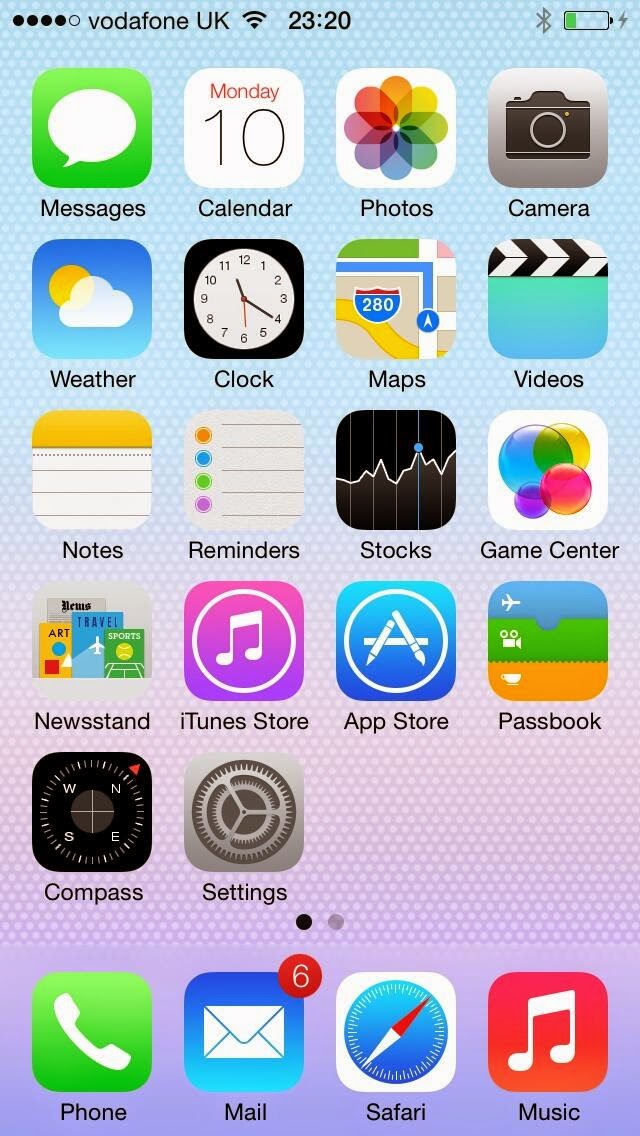What apps are on your home screen? (#HomeScreenSurvey)
Competing in the app economy isn't as easy as you may think. Last year, I read some studies on app usage and app abandonment rate that scared the marketer in me. Here's a paragraph from a TechCrunch article listing many of the sources:
"Back in 2011, around a quarter of mobile apps were downloaded, used once then abandoned. Today’s users are far more fickle, given their greater choice. According to Mobilewalla founder Anindya Datta, speaking to USA Today last year, an estimated 80 to 90 percent of apps are eventually deleted from users’ phones.
Talk about having only one chance to make a good first impression."
First impressions are important, it would appear. At first, this sounded a bit over the top. Over 80% of apps were likely to fail the first impression test and get deleted, immediately or consigned to the waste bin of screen 3, 4 and 5 on your phone. Over the top until you look at your own phone and think about how many apps you regularly use that AREN'T on the home screen. Try it.
Which makes me wonder, just who are we competing with when we build apps and try to get people to use them? I'll give you a clue, it's the big guys. And they're winning at the moment!
Over the course of this past week, I asked my followers on Twitter to submit screenshots of their home screens, compiled the data and tried to gather some insights on what must be 80-90% of app usage on their smartphones. I doubt this is a statistically significant sample - but it's a sample nonetheless. Most likely:
Please leave any comments around insights you may have picked up. Here are a couple of things I found interesting:
And finally, from a business perspective. Hopefully now you can see how tough this world of apps is. Not only do you have to be discovered inside the app store. But you've somehow got to get onto the primary screen - or your usage is going to be an uphill battle.
"Back in 2011, around a quarter of mobile apps were downloaded, used once then abandoned. Today’s users are far more fickle, given their greater choice. According to Mobilewalla founder Anindya Datta, speaking to USA Today last year, an estimated 80 to 90 percent of apps are eventually deleted from users’ phones.
Talk about having only one chance to make a good first impression."
First impressions are important, it would appear. At first, this sounded a bit over the top. Over 80% of apps were likely to fail the first impression test and get deleted, immediately or consigned to the waste bin of screen 3, 4 and 5 on your phone. Over the top until you look at your own phone and think about how many apps you regularly use that AREN'T on the home screen. Try it.
Which makes me wonder, just who are we competing with when we build apps and try to get people to use them? I'll give you a clue, it's the big guys. And they're winning at the moment!
Over the course of this past week, I asked my followers on Twitter to submit screenshots of their home screens, compiled the data and tried to gather some insights on what must be 80-90% of app usage on their smartphones. I doubt this is a statistically significant sample - but it's a sample nonetheless. Most likely:
- tech savvy, Twitter users who follow @andyhadfield :)
- iOS dominant (this was interesting, over 90% of respondents were on iOS)
- know how to take a screenshot
In the spirit of open source, here's a link to the 54 home screens that were submitted and the Excel I put together to work out the frequency of particular apps. Do with it what you will. Credit and link back here if you please.
I'd love someone with a bit of a research bent to dig into this a little more. Until that person pops up, I've put together a little frequency map for you to have a look at - with some of my findings / thoughts below.
Rules I applied:
- Just the home screen apps were noted down
- Apps within folders were ignored (because I couldn't be sure exactly which apps they were)
- Folder names were jotted down
- Folder names that were almost exactly the same were combined (eg. Photography vs Photographic)
- Widgets (eg. weather) on Android home screens were indicated as such
So here we go, 228 unique apps, in order of frequency, that appeared on the 54 screenshots of home screens submitted to me on Twitter:
Please leave any comments around insights you may have picked up. Here are a couple of things I found interesting:
- The dominance of iOS was odd in the sample.
- Embedded Apple apps were obviously the strongest - didn't expect anything different.
- Twitter and Instagram beat out Facebook, only just. This may have been because the sample was more Twitter orientated. Twitter beat out Facebook quite heavily if you count 3rd party Twitter apps.
- Clock and Torch apps still rank highly, even though iOS 7 allows you to swipe up from the bottom to access those functions (I personally removed both these apps off my home screen when that happened - saved some space).
- Chrome is moving up the ranks but Safari is still almost double the frequency. Again, the Twitter audience is likely more tech-savvy hence the presence of Chrome.
- Why on earth would people include the Contacts app on your home screen when you can get to it via the Phone button?
- Everyone has the "Phone" app - except one person.
- Folders are popular.
- Both iTunes Store (indicator that buying music is increasing locally?) and the App Store / Google Play Store performed strongly. The presence of an App Store is just more evidence of our dopamine-based app culture. Quick hits of "trying out new stuff" before deleting and moving back to what our phones are really for - utility.
- Paid for navigation apps (eg. TomTom) have a tough job where the alternatives are great and free.
- Banking apps (FNB and Standard Bank were the only ones to make an appearance in this sample) aren't quite the home screen stalwarts I suspected they might be. Or they were consigned to a folder...
- ... and then there's the long tail. One of the most fascinating things about this list is the sheer volume of apps I've barely heard of that users have deemed important enough to occupy that valuable home screen. Browse through it - there's some dopamine to be had.
And finally, from a business perspective. Hopefully now you can see how tough this world of apps is. Not only do you have to be discovered inside the app store. But you've somehow got to get onto the primary screen - or your usage is going to be an uphill battle.
What else can you figure out?



This comment has been removed by the author.
ReplyDeletet's important to remember that most Android users don't know how to capture a screenshot.
ReplyDeleteAnd it's different across manufacturers and OS versions. Some phones like the Samsung Galaxy S line require your to sweep your palm across the screen while Android Kitkat requires the power and volume down buttons be pressed simultaneously.
Apple seems to somehow taught most iOS users (without the use of a manual) how to take a screenshot.
This might have resulted in the low Android numbers.
This was interesting but a few points immediately popped into mind:
ReplyDelete1. Due to the huge difference in iOS v Android samples the bare numbers don’t tell you anything about different preferences between users of the two systems. If you expressed the number of users with a particular App on the home screen as a percentage of the total number of users of the relevant OS it would provide more useful comparative information about the preferences of each group. The sample is still too small and too skewed to be statistically significant but interesting nevertheless.
2. Differences between alternative routes to access a particular functionality may affect choices by users of each OS. For example on Android “Settings” can be accessed by swiping down from the top of the home screen. There is thus no need to place the “Settings” Applet on the home screen or anywhere for that matter.
3. My home screen has:
Row 1 - The Android Clock and Weather widget
Row 2 - Evernote, Calendar, WhatsApp, WeatherSA,
Row 3 – Camera, TMemo, Google Maps and Google Navigation
Row 3 – (Appears on all screens) Phone, Contacts, GMail. Messaging and Apps.
All from the "big boys" as you say.
4. As an Android user there are a few points I would make about interpreting Home Screen shortcut choices.
- On some phones (Samsung S* series for example) the bottom row of icons does not scroll as you move to other screen pages. i.e. These icons appear at the bottom of all screens either side of the home screen.
- The bottom right icon on my home screen accesses the “App Drawer” giving access to every App on your device.
- You can elect to use WhatsApp or Google + and probably several other messaging Apps to handle all messaging functions including SMS. I don’t but if you use this you could free up a place on the home screen for something presently relegated to another screen. If I did this I would probably elect to put Opera Mini (Browser) where the “Messaging” App presently sits.
- I keep my contacts on the home screen although this is not necessary as the “Phone” App brings up a tabbed screen offering direct access to Keypad, Logs, Favourites and Contacts. This is what I meant when I mentioned different routes to access a particular functionality.
- Voice control works well on Android for voice controlled dialling and opening Apps from the SVoice App. I don’t use it much (kind of feel silly talking to my phone in public) but if this doesn't phase you or you like to show off then it may influence the choice of short-cuts on the home screen.
Finally, as Phillip mentioned in his comments most Android users do not know how to take a screenshot. This has changed with recent Android versions and differs from make to make. I am sure there are also a lot of iOS users who also have no idea how to do this, which means your sampling method is skewed toward users who are anything but average.